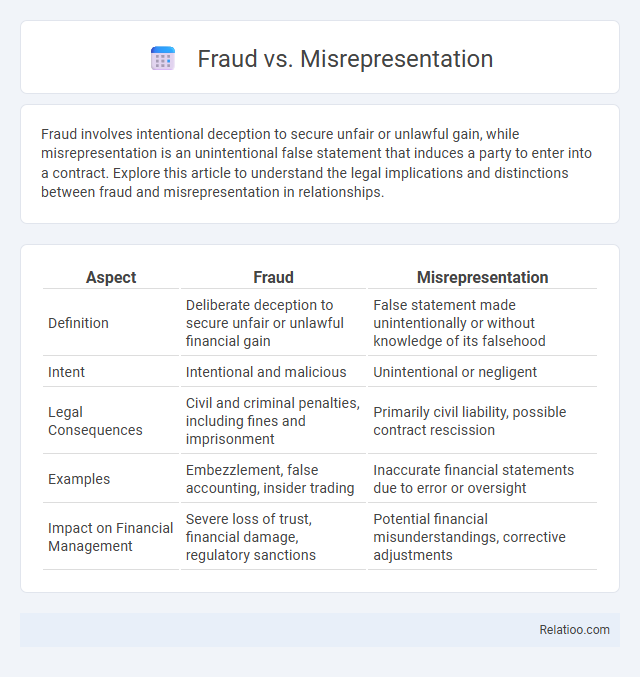Fraud involves intentional deception to secure unfair or unlawful gain, while misrepresentation is an unintentional false statement that induces a party to enter into a contract. Explore this article to understand the legal implications and distinctions between fraud and misrepresentation in relationships.
Table of Comparison
| Aspect | Fraud | Misrepresentation |
|---|---|---|
| Definition | Deliberate deception to secure unfair or unlawful financial gain | False statement made unintentionally or without knowledge of its falsehood |
| Intent | Intentional and malicious | Unintentional or negligent |
| Legal Consequences | Civil and criminal penalties, including fines and imprisonment | Primarily civil liability, possible contract rescission |
| Examples | Embezzlement, false accounting, insider trading | Inaccurate financial statements due to error or oversight |
| Impact on Financial Management | Severe loss of trust, financial damage, regulatory sanctions | Potential financial misunderstandings, corrective adjustments |
Understanding Fraud and Misrepresentation
Fraud involves intentional deception to secure unfair or unlawful gain, characterized by deliberate false representation or concealment of important facts, while misrepresentation may be innocent, negligent, or fraudulent and pertains to false statements inducing another party to enter a contract. Understanding the nuances between fraud and misrepresentation is crucial for protecting Your legal rights and ensuring informed decision-making. Recognizing intentional fraud requires proof of intent to deceive, whereas misrepresentation focuses more on the effect of the false information on contractual agreements.
Key Differences Between Fraud and Misrepresentation
Fraud involves intentional deception to secure unfair or unlawful gain, whereas misrepresentation typically refers to false statements made without intent to deceive but that induce another party to enter into a contract. Key differences between fraud and misrepresentation lie in the element of intent and the resulting legal consequences; fraud requires intentional wrongdoing and often leads to punitive damages, while misrepresentation can be innocent, negligent, or fraudulent, impacting remedies available for Your case. Understanding these distinctions helps You determine the appropriate legal strategy and potential compensation.
Elements Required to Prove Fraud
The elements required to prove fraud include a false representation of a material fact, knowledge of its falsity (scienter), intent to induce reliance, justifiable reliance by the victim, and resulting damages. Misrepresentation involves false statements but lacks the intent or knowledge element necessary for fraud, often leading to different legal remedies such as rescission rather than damages. Fraud distinguishes itself by the deliberate deception aimed at securing an unfair or unlawful gain, demanding clear and convincing evidence of intent and harm.
Essential Components of Misrepresentation
Misrepresentation involves a false statement of fact that induces You to enter into a contract, differing from fraud primarily in the absence of intent to deceive. Essential components of misrepresentation include a false representation, reliance by the innocent party, and resulting damage or loss. Unlike fraud, which requires deliberate intent, misrepresentation can be negligent or innocent but still voids a contract if these elements are proven.
Legal Consequences of Fraud
Fraud involves intentional deception to secure unlawful gain or cause harm, leading to severe legal consequences such as criminal prosecution, civil penalties, and potential imprisonment. Unlike misrepresentation, which may be innocent or negligent and typically results in contract rescission or damages, fraud carries stricter scrutiny due to its deliberate nature. Courts impose punitive damages and enhanced remedies in fraud cases to deter malicious conduct and protect the integrity of legal transactions.
Legal Implications of Misrepresentation
Misrepresentation, unlike fraud, involves false statements that induce another party to enter a contract without intent to deceive, leading primarily to rescission or damages based on negligence or innocent misstatements rather than criminal liability. Legal implications of misrepresentation include contract voidability, allowing the misled party to annul the agreement and seek restitution, but unlike fraud, it generally does not result in punitive damages or criminal prosecution. Courts distinguish misrepresentation by its lack of fraudulent intent, emphasizing remedies aimed at restoring the injured party rather than punishing the perpetrator.
Common Examples of Fraud in Practice
Common examples of fraud in practice include intentional falsification of financial statements, identity theft, and insurance claim scams designed to deceive for monetary gain. Misrepresentation often involves unintentional or negligent false statements affecting contract agreements, whereas fraud requires deliberate deceit. Understanding these distinctions helps you protect your assets and avoid legal pitfalls.
Typical Cases of Misrepresentation
Typical cases of misrepresentation involve false statements that induce another party to enter into a contract without intent to deceive, such as innocent misstatements about a product's qualities or services offered. Unlike fraud, which requires intentional deceit and knowledge of falsehood, misrepresentation can be innocent or negligent, often arising in real estate transactions where sellers inaccurately describe property features. Courts differentiate these scenarios based on the defendant's state of mind, affecting remedies like rescission or damages.
Defenses Against Fraud and Misrepresentation Claims
Defenses against fraud and misrepresentation claims include proving the absence of a false statement, lack of intent to deceive, or demonstrating that the plaintiff did not rely on the misrepresentation. Establishing that the misrepresentation was a statement of opinion rather than fact or that the plaintiff had equal knowledge can also serve as valid defenses. In fraud cases, showing that the plaintiff failed to conduct due diligence or that there was no causal connection between the alleged fraud and the damages can help mitigate liability.
How Courts Distinguish Fraud from Misrepresentation
Courts distinguish fraud from misrepresentation by evaluating the intent and knowledge behind the false statement; fraud requires intentional deception with the purpose of inducing reliance, while misrepresentation may involve negligent or innocent false statements without intent to deceive. The presence of scienter, or knowledge of falsity, is crucial in proving fraud, whereas misrepresentation does not necessarily require proof of intent, only that the statement was false and relied upon. Your understanding of these differences is essential in legal contexts where the severity of claims and remedies vary based on whether the act was knowingly fraudulent or merely a misrepresentation.

Infographic: Fraud vs Misrepresentation
 relatioo.com
relatioo.com